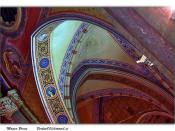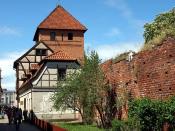A cathedral is a work of art, no matter its "type"�. Most cathedrals take decades or more of planning, building, and sweating. To construct such a masterpiece can only be done with the help of God's grace. The effort is worth the result. Cathedrals are majestic edifices, and some are the perfect examples of Gothic architecture.
Gothic art and architecture had their roots in France in about 1140, and spread to the rest of Europe in the following century. Today, many cathedrals throughout the world can be categorized as Gothic cathedrals. These cathedrals demonstrate the characteristics synonymous with the Gothic style. Most qualities of Gothic architecture depend on structural development.
The ribbed vault is a common attribute to Gothic architecture. This structure consists of thin arches of stone. These arches run diagonally, transversely, and longitudinally. This vault enabled ceilings to become higher because pressure was exerted downward, and flying buttresses (another key Gothic trait) helped to ease the excess pressure.
This relief of pressure enabled walls to become thinner than ever before. Not only are thinner walls a characteristic of Gothic architecture, they also allow yet another Gothic feature to come into play, stained glass windows.
Personally, I think the stained glass windows are the most detailed and artistic features of Gothic architecture. They do not really allow large amounts of light to filter through them. They provide more of a "luminous darkness"�. The usual dominant colors include dark blues and vibrant ruby reds. Many times, bible scenes are portrayed on these windows. Frequently, one will find that the lives of the saints are displayed on windows of the side aisles.
With the ribbed vault, the ground plan could be a variety of shapes. The most common Gothic floor plan consists of three aisles with a long nave, or...


